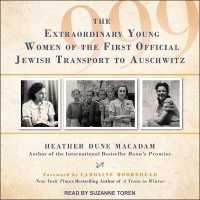Full Description
Considering that Orkney is a group of relatively small islands lying off the northeast coast of the Scottish mainland, its wealth of Neolithic archaeology is truly extraordinary. An assortment of houses, chambered cairns, stone circles, standing stones and passage graves provides an unusually comprehensive range of archaeological and architectural contexts. Yet, in the early 1990s, there was a noticeable imbalance between 4th and 3rd millennium cal BC evidence, with house structures, and 'villages' being well represented in the latter but minimally in the former. As elsewhere in the British Isles, the archaeological visibility of the 4th millennium cal BC in Orkney tends to be dominated by the monumental presence of chambered cairns or tombs. In the 1970s Claude Levi-Strauss conceived of a form of social organisation based upon the'house' - societes a maisons - in order to provide a classification for social groups that appeared not to conform to established anthropological kinship structures. In this approach, the anchor point is the 'house', understood as a conceptual resource that is a consequence of a strategy of constructing and legitimising identities under ever shifting social conditions. Drawing on the results of an extensive programme of fieldwork in the Bay of Firth, Mainland Orkney, the text explores the idea that the physical appearance of the house is a potent resource for materialising the dichotomous alliance and descent principles apparent in the archaeological evidence for the early and later Neolithic of Orkney. It argues that some of the insights made by Levi-Strauss in his basic formulation of societesa maisons are extremely relevant to interpreting the archaeological evidence and providing the parameters for a 'social' narrative of the material changes occurring in Orkney between the 4th and 2nd millennia cal BC. The major excavations undertaken during the Cuween-Wideford Landscape Project provided an unprecedented depth and variety of evidence for Neolithic occupation, bridging the gap between domestic and ceremonial architecture and form, exploring the transition from wood to stone and relationships between the living and the dead and the role of material culture. The results are described and discussed in detail here, enabling tracing of the development and fragmentation of societes a maisons over a 1500 year period of Northern Isles prehistory.
Contents
ContentsAcknowledgementsList of figuresList of tablesChapter 1 Images of Neolithic Orkney Colin Richards & Richard JonesChapter 2 Houses of the dead: the transition from wood to stone architecture at Wideford HillColin Richards & Andrew Meirion JonesChapter 3 Place in the Past: an early Neolithic house at the Knowes of Trotty barrow cemetery, Harray, Mainland, OrkneyJane Downes, Paul Sharman, Adrian Challands, Patricia D. Voke, Erika Guttmann-Bond, Jo McKenzie & Roy Towers Chapter 4 Local histories of passage grave building communities: Brae of Smerquoy Christopher Gee, Colin Richards & Mairi RobertsonChapter 5 Good neighbours: Stonehall Knoll, Stonehall Meadow and Stonehall Farm Colin Richards, Kenny Brophy, Martin Carruthers, Andrew Meirion Jones, Richard Jones & Sian JonesChapter 6 At Stonehall Farm, late Neolithic life is rubbish Colin Richards, Richard Jones, Adrian Challands, Andrew Meirion Jones, Sian Jones & Tom Muir Chapter 7 The settlement of Crossiecrown: the Grey and Red HousesNick Card, Jane Downes, Richard Jones, Colin Richards & Antonia ThomasChapter 8 Reorientating the dead of Crossiecrown: Quanterness & Ramberry HeadRebecca Crozier, Colin Richards, Judith Robertson & Adrian ChallandsChapter 9 Materializing Neolithic house societies in Orkney, introducing Varme Dale & MuckquoyColin Richards, Jane Downes, Christopher Gee & Stephen CarterChapter 10 Beside the ocean of time: a chronology of Neolithic burial monuments and houses in OrkneySeren Griffiths Chapter 11 Prehistoric pottery from sites within the Bay of Firth: Stonehall, Crossiecrown, Wideford Hill, Brae of Smerquoy, Muckquoy, Ramberry and Knowes of Trotty Andrew Meirion Jones, Richard Jones, Gemma Tully, Lara Maritan, Anna Mukherjee, Richard Evershed, Ann MacSween, Colin Richards & Roy TowersChapter 12 Flaked lithic artefacts from Neolithic sites around the Bay of Firth: Wideford Hill, Knowes of Trotty, Brae of Smerquoy, Stonehall, Crossiecrown and Ramberry Hugo Anderson-Whymark, Richard Chatterton, Mark Edmonds & Caroline Wickham-JonesChapter 13 The coarse stone from Neolithic sites around the Bay of Firth: Stonehall, Wideford Hill, Crossiecrown, Knowes of Trotty and Brae of SmerquoyAnn Clarke Chapter 13.1 The pumice from Crossiecrown and Stonehall Ann Clarke Chapter 13.2 The black stone bead from Structure 1, Stonehall FarmAlison SheridanChapter 13.3 The haematite and iron-rich materials Effie Photos-Jones, Arlene Isbister & Richard JonesChapter 14 The animal remains from Stonehall and CrossiecrownCatherine Smith & Julie A. RobertsChapter 14.1 The human remains from Ramberry HeadDavid LawrenceChapter 15 Bay of Firth environments from the 2nd to 4th millennium BC: the evidence from Stonehall, Wideford Hill, Crossiecrown, Knowes of Trotty, Varme Dale & Brae of Smerquoy Jennifer Miller, Susan Ramsay, Diane Alldrit & Joanna BendingChapter 15.1 Palaeoenvironmental investigation of a peat core from Stonehall Susan Ramsay, Stephanie Leigh-Johnson & Rupert HousleyChapter 16 The micromorphological analysis of soils and site contexts at Stonehall and CrossiecrownCharles A. I. FrenchBibliographyIndex





